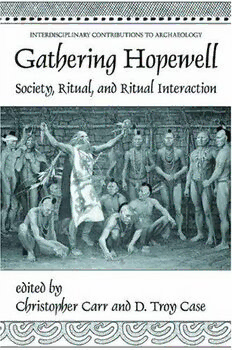
Gathering Hopewell: Society, Ritual, and Ritual Interaction (Interdisciplinary Contributions to Archaeology) PDF
818 Pages·2005·7.264 MB·English
Most books are stored in the elastic cloud where traffic is expensive. For this reason, we have a limit on daily download.
Preview Gathering Hopewell: Society, Ritual, and Ritual Interaction (Interdisciplinary Contributions to Archaeology)
Description:
Among the most socially and personally vocal archaeological remains on the North American continent are the massive and often complexly designed earthen architecture of Hopewellian peoples of two thousand years ago, their elaborately embellished works of art made of glistening metals and stones from faraway places, and their highly formalized mortuaries. In this book, twenty-one researchers in interwoven efforts immerse themselves and the reader in this vibrant archaeological record in order to richly reconstruct the societies, rituals, and ritual interactions of Hopewellian peoples. By finding the faces, actions, and motivations of Hopewellian peoples as individuals who constructed knowable social roles, the authors explore, in a personalized and locally contextualized manner, the details of Hopewellian life: leadership, its sacred and secular power bases, recruitment, and formalization over time; systems of social ranking and prestige; animal-totemic clan organization, kinship structures, and sodalities; gender roles, prestige, work load, and health; community organization in its tri-scalar residential, symbolic, and demographic forms; intercommunity alliances and changes in their strategies and expanses over time; and interregional travels for power questing, pilgrimage, healing, tutelage, and acquiring ritual knowledge. These and other aspects of Hopewellian life are revealed through the assembly of comprehensive data bases of unprecedented scale, most of which are fully reported in CD form for the benefit of other researchers. This book is useful to scholars, graduate students, and advanced undergraduates interested in the workings and development of social complexity at local and interregional scales, recent theoretical developments in the anthropology of the topics listed above, the prehistory of eastern North America, its history of intellectual development, and Native American ritual, symbolism, and belief.
See more
The list of books you might like
Most books are stored in the elastic cloud where traffic is expensive. For this reason, we have a limit on daily download.
